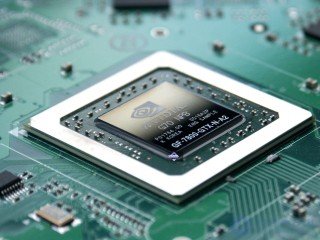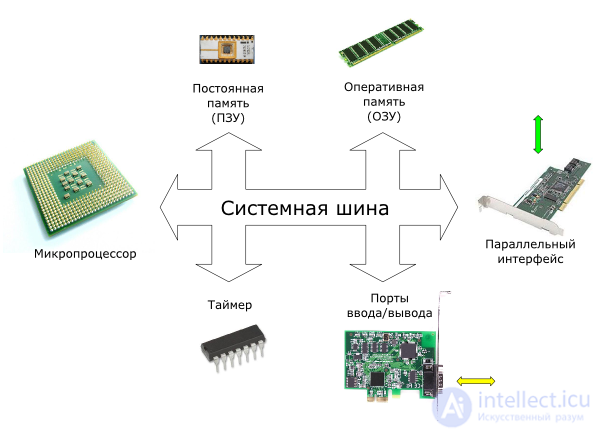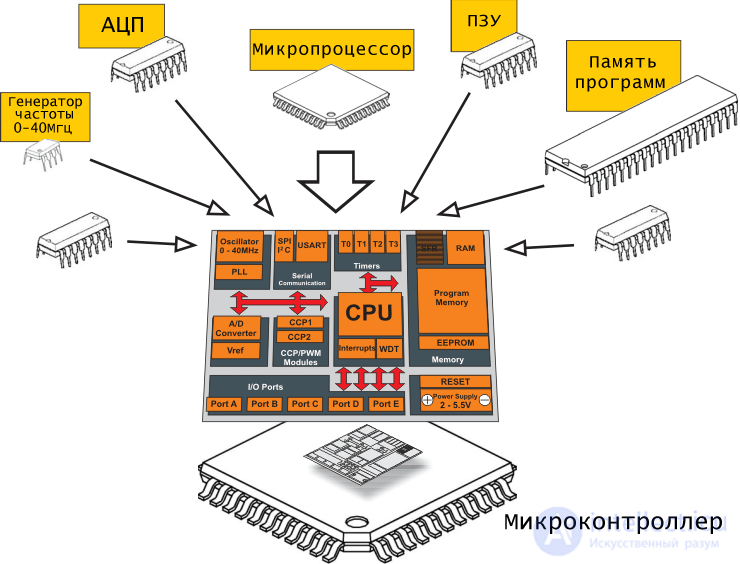Lecture
Let's see what is really different and what are the similarities between these two types of digital electronic devices.
Both the microprocessor and the microcontroller are designed to perform some operations — they retrieve commands from memory and execute these instructions (representing arithmetic or logical operations) and the result is used to service output devices. Both the microcontroller and microprocessor are capable of continuously sampling commands from the memory and executing these instructions while power is being supplied to the device. The instructions are sets of bits. These instructions are always taken from their storage, which is called memory.
The microprocessor (in MPU - Micro Processor Unit) contains the functionality of a computer central processor, or CPU (Central Processing Unit) on a single semiconductor chip (IC - integrated circuit or in the Western style - Integrated Circuit).

NVIDIA GPU
At its core, it is a microcomputer that is used to perform arithmetic and logical operations, control systems, store data, and others.
The microprocessor processes the data coming from the input peripheral devices and transfers the processed data to the output peripheral devices.
There are four main types of processors that differ in their architecture.
Microprocessors with a full set of commands (Complex Instruction Set Computer, CISC-architecture). Characterized by the non-fixed value of the command length, the encoding of arithmetic operations by one command, a small number of registers performing strictly defined functions. An example of this type of processor is the x86 family.
Microprocessors with reduced instruction set (Reduced Instruction Set Computer, RISC-architecture). They have, as a rule, increased speed by simplifying instructions, which allows us to simplify the decoding process and, consequently, reduce their execution time. Most GPUs are developed using this type of architecture.
Microprocessors with a minimal set of commands (Minimal Instruction Set Computer, MISC-architecture). Unlike the RISC-architecture, they use long command words, which allows you to perform quite complex actions in one cycle of the device. The formation of long “command words” became possible due to the increase in the capacity of microprocessor devices.
In superscalar processors (Superscalar Processors) several command decoders are used that load the work of many execution units. Scheduling the execution of a stream of commands occurs dynamically and is carried out by the computing core itself. An example of a processor with this type of architecture is, for example, the Cortex A8.
Separately, I want to highlight special purpose microprocessors (ASIC - Application Specific Integrated Circuit). As the name implies, are intended to solve a specific problem. In contrast to general-purpose microprocessors, they are used in a specific device and perform certain functions characteristic of only this device. Specialization in the implementation of a narrow class of functions leads to an increase in the speed of the device and, as a rule, reduces the cost of such an integrated circuit. Examples of such microprocessors can be a chip designed exclusively for controlling a mobile phone, chips for hardware encoding and decoding audio and video signals - so-called Digital Signal Processing (DSP multiprocessors). Can be implemented as a FPGA (programmable logic integrated circuit). When developing such processors, hardware description languages (HDL - Hardware Description Language), such as Verilog and VHDL, are used to describe their functionality.
Systems based on microprocessors are built approximately as follows.

Microprocessor based system
As you can see, the microprocessor in this system has many auxiliary devices, such as read-only memory, RAM, serial interface, timer, I / O ports, etc. All these devices exchange commands and data with the microprocessor via the system bus. All auxiliary devices in the microprocessor system are external. The system bus, in turn, consists of an address bus, a data bus, and a control bus.
Now, let's take a look at the microcontroller.
Below is a block diagram of the microcontroller. What is its main difference from the microprocessor? All reference devices, such as read-only memory, RAM, timer, serial interface, I / O ports, are built-in. Therefore, there is no need to create interfaces with these assistive devices, and this saves a lot of time for the system developer.

Internal device of the microcontroller
A microcontroller is nothing more than a microprocessor system with all supporting devices integrated in a single chip. If you want to create a device that interacts with external memory or a DAC / ADC block, you only need to connect the appropriate DC power supply, a reset circuit, and a quartz crystal (clock source). They are simply problematic to integrate into a semiconductor crystal.
The core of the microcontroller (central processor) is usually built on the basis of the RISC architecture.
A program recorded in the memory of the microcontroller can be protected from the possibility of its subsequent reading / writing, which provides protection against its unauthorized use.
| Microprocessor | Microcontroller | |
| Using | Computer systems | Embedded Systems |
| Device | Contains CPU, general registers, stack pointers, program counters, timer, and interrupt circuits | Contains a microprocessor circuit and has built-in ROM, RAM, input / output devices, timers and counters. |
| Data memory | It has many instructions for moving data between memory and processor. | It has one or two instructions for moving data between the memory and the processor. |
| Electrical circuits | High complexity | Simple enough |
| Expenses | The cost of the whole system increases | Low system cost |
| Number of registers | It has a smaller number of registers, operations are mainly performed in memory. | It has a greater number of registers, so it is easier to write programs. |
| Memory device | Based on the von Neumann architecture. Program and data are stored in the same memory module. | Based on Harvard architecture. Programs and data are stored in different memory modules. |
| Access time | Memory and I / O access time is longer. | Shorter access times for onboard memory and I / O devices. |
| Iron | Requires more hardware. | Requires less hardware. |
Comments
To leave a comment
Digital devices. Microprocessors and microcontrollers. computer operating principles
Terms: Digital devices. Microprocessors and microcontrollers. computer operating principles